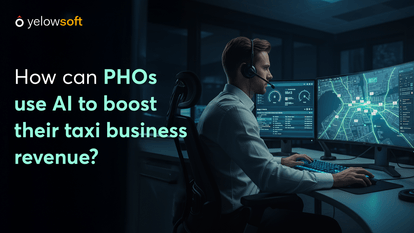You are entering a year where pricing rules in the mobility industry are changing faster than most operators expected.
Several states in the United States have begun questioning how fares rise during peak times and why certain riders pay more than others.
This new attention puts every company that relies on AI Dynamic pricing under pressure.
Regulators believe some systems behave in ways that customers cannot understand, and this concern has pushed them to cap or limit surge pricing in taxi operations.
If you run a fleet or manage bookings, you already know how important a clear and predictable dynamic pricing modelis for your margins. You also know how quickly trust can disappear when riders feel confused.
In this blog you will read what these new rules mean for you, how a strong customer communication system protects transparency, and why a Govt. compliant dispatch software is now essential for long term stability.
The Changing Landscape of AI Pricing in Mobility
You are now working in a market where pricing rules are being rewritten while you operate. The way your fares adjust during busy hours is no longer seen as a simple business decision.
Regulators want to know how your system collects data, how it calculates a multiplier, and whether every rider is treated the same.
This is why AI dynamic pricing has become a central topic in policy discussions.
Lawmakers believe some models rely on information that riders never agreed to share, and that concern has created real pressure for operators like you.
If you depend on a dynamic pricing model to stay profitable, you need to understand how these changes affect your daily work.
You also need tools that support transparent logic. Most advanced dispatch systems such as Yelowsoft Taxi Dispatch Software now focus on clear rules that can be explained and defended.
How Much Do You Trust AI Powered Surge Pricing
Before you read further, choose the option that feels closest to your experience.
What Regulators Mean by Surveillance Based Pricing
When you hear the term surveillance based pricing, it may sound like something distant or technical, but regulators use it in a very specific way.
They are focused on pricing systems that quietly study a rider’s behavior, location habits, spending patterns or personal traits, then use that information to raise or adjust a fare.
This is where AI dynamic pricing becomes a concern for lawmakers. The idea that two riders can request the same trip at the same moment and receive different prices simply because an algorithm predicts who is willing to pay more has raised serious questions about fairness.
You already know how important transparency is in surge pricing in taxi operations.
You may even have seen moments where customers lost trust because they did not understand why a price changed.
There is an old proverb that says trust arrives on foot but leaves on horseback. That is exactly how fragile customer confidence becomes when pricing feels unclear.
To avoid this problem, platforms with fair dispatch logic such as Yelowsoft AI based Auto Dispatch rely on open and explainable rules rather than hidden data patterns.
State by State Breakdown of 2025 Pricing Regulations
You are now dealing with a regulatory landscape that is changing in real time.
Different states have introduced rules that shape how your fares can be calculated and what information your system can use.
Understanding these laws helps you adjust your pricing strategy without facing surprises later.
Colorado HB 25 1264
Colorado has taken one of the strongest positions against hidden algorithmic pricing.
The bill bans surveillance based price discrimination and applies to any automated decision system that personalizes fares.
If your operation relies on AI dynamic pricing, you are expected to use clear and standardized pricing rules found in the Pricing and Billing Module to avoid crossing these new boundaries.
Illinois SB 2255
Illinois SB 2255 focuses on stopping individualized pricing that relies on behavioral or personal signals.
The bill also places limits on consumer scoring models that feed pricing engines.
If you depend on a dynamic pricing model to manage demand, you must ensure the system applies the same logic to every rider instead of adjusting fares based on personal traits.
New York’s Algorithmic Pricing Disclosure Rules
New York has moved toward transparency by requiring platforms to disclose when personal data influences a fare.
This affects both customer communication and driver pay visibility. If your pricing depends on AI dynamic pricing, you need to explain which data signals influence the outcome and make sure every rider understands the factors behind the final fare.
Washington Surge Cap Proposals
Washington is considering event based limits that restrict how far surge multipliers can rise during peak moments such as major games or international events.
These rules also focus on protecting driver earnings. If you rely on surge pricing in taxi operations, you must prepare for regional caps that keep your multipliers within a fixed and published range.
Federal Trend: Price Gouging Prevention Acts
At the federal level, several proposals are targeting AI based price manipulation. These efforts focus on fairness and the need for consistent logic across all riders.
If national rules move forward, your system will need to rely on predictable formulas rather than opaque behavior driven adjustments.
Using a Govt. regulation compliant dispatch software becomes important because it gives you the structure to adapt quickly to federal expectations.
Quote from Abrez Shaikh
There is a growing belief among regulators that pricing should be both explainable and defendable.
This aligns closely with the perspective of Yelowsoft Product Manager Abrez Shaikh. He puts it in simple terms:
“Pricing must be transparent, explainable, and fair. A system that cannot justify a fare cannot protect a business.” — Abrez Shaikh, Product Manager, Yelowsoft
His message is important because it reflects the direction in which policy makers are moving.
You are expected to operate in a way that removes confusion and builds trust.
If a rider questions a fare, your system should be able to show why the price changed, which inputs were used, and how the same rules apply to every rider.
This approach not only keeps you aligned with new laws but also helps you maintain long term confidence among your customers.
Which Pricing Practices Are Becoming Illegal or High Risk
You now need to pay close attention to how your fares are calculated, because several pricing methods are attracting direct regulatory action.
These patterns may look harmless from an operational point of view, but lawmakers see them as unfair or opaque.
Understanding them helps you adjust your dynamic pricing model in the right direction.
Personalized Willingness to Pay Algorithms
These algorithms adjust fares based on a rider’s predicted urgency or spending behavior. They violate new laws because they treat identical riders differently without a justifiable reason.
If you use AI dynamic pricing, you must avoid signals that guess who will pay more.
Regulators call this manipulation rather than genuine demand based pricing.
User Level Price Variation for Same Route
This happens when two riders request the same trip and receive different fares because their personal data differs. It is seen as unfair individual level pricing.
A predictable dynamic pricing model should apply the same rule to everyone. See how one can implement dynamic pricing in the taxi dispatch software fairly.
Demographic, Behavioral, or Device Based Pricing
Using age, neighborhood, shopping patterns, or even device type to set fares is now seen as surveillance.
Regulators argue that such inputs have nothing to do with real demand.
If your AI dynamic pricing engine uses these signals, it may be classified as discriminatory, regardless of how minor the variation appears.
Opaque Fare Structures Without Explanation
Even if your multipliers are fair, a lack of explanation can damage trust. As mentioned earlier, trust arrives on foot but leaves on horseback.
Riders expect simple and consistent reasoning behind every increase. A transparent dynamic pricing model supported by clear communication avoids the perception of hidden or unfair pricing.
How to Communicate Pricing to Protect Customer Trust
Even the fairest pricing rules can fail if riders do not understand how they work. Trust depends on clarity.
When you explain your process in simple language, riders feel respected and informed.
This is where a strong customer communication system becomes essential.
Running your operation without clear communication invites confusion and unnecessary complaints. Simple and timely updates help you avoid that.
Break Down Fares Before the Trip
Riders appreciate seeing how a fare is formed before they decide to book. A clear breakdown of time, distance and any active multiplier prevents misunderstandings.
When customers see this information upfront, they rarely question the final amount because the reasoning behind the number is already prepared for them.
Use Simple Language to Explain Surge Causes
When demand rises, tell riders exactly why. Maybe supply is low or a major event has started.
Keep the explanation calm and direct. Customers are more accepting when they know the cause rather than guessing.
Clear explanations stop frustration before it begins and reduce doubts about fairness.
Provide Clear Receipts and Policy Pages
After the trip, provide a complete receipt with every component of the fare.
Include a link to your pricing policy in case someone wants more detail. When everything is open and easy to review, you avoid unnecessary complaints and increase overall confidence in your service.
What Operators Should Do Now to Stay Ahead of Regulations
You can prepare for upcoming changes by reviewing every part of your pricing setup.
Start by auditing the data your system uses to calculate fares. Remove any signal that feels personal, behavioral or unrelated to real demand.
Update your policies so riders know exactly how your prices work. Train your team to explain these rules in simple terms.
Configure region specific profiles so your system adapts to local requirements.
When you build your process inside a Govt. regulated compliant dispatch software, you stay in control even when the rules change around you.
Conclusion
You are entering a period where pricing rules demand more clarity than ever.
The fastest way to stay confident is to rely on open logic, simple explanations and a structure that treats every rider fairly.
When you use transparent methods instead of hidden data signals, your pricing becomes easier to defend and easier for customers to trust.
You already know that compliance is not about limiting your growth but about protecting it.
As these regulations evolve, your ability to adapt will set you apart. Clear rules, honest communication and the right tools will keep your business future ready.
Build A Future Ready Pricing System That Protects Revenue And Customer Trust
Frequently Asked Questions
No. AI dynamic pricing is not banned. What regulators are targeting is pricing that uses hidden personal signals or behavior based predictions. You can still adjust fares based on demand, supply and cost, as long as the rules apply equally to every rider.
Surveillance based pricing refers to fares influenced by personal traits, device type, browsing behavior or location history. These signals do not reflect real demand. Laws focus on stopping systems that change prices based on who the rider is rather than the conditions around the trip.
Yes. A dynamic pricing model based on real supply and demand is allowed. You only need to avoid personal data inputs. As long as your multipliers are tied to time, location, event conditions or zone activity, your pricing remains safe and compliant.
A strong customer communication system explains every fare clearly. When riders see the reason behind a surge and receive timely updates, confusion drops. Simple messages about demand levels, trip conditions and fare components help you maintain trust even during busier hours.
A Govt. compliant dispatch software should offer region based pricing profiles, clear fare logs, transparent formulas, audit ready records and controls that prevent personal data from influencing fares. These features help you align with regulations and keep your pricing structure predictable and fair.




